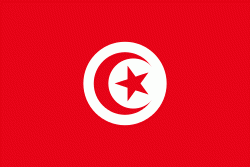Manouba Governorate (Manouba)
The governorate is 5.5 km from the capital, in an area of foothills of and verdant plains below the Tell Atlas uplands and borders Bizerte, Zaghouan, Beja, Tunis, Ariana and Ben Arous Governorates. The east and west of the province have high foothills; from both ranges the three lakes of Tunis and the Bay of Tunis can be seen. The east part of the west range is named the Forest of Tebourba, one of its four largest settlements.
The average temperature is 18.7 °C and annual rainfall is 450 millimeters.
Map - Manouba Governorate (Manouba)
Map
Country - Tunisia
 |
 |
| Flag of Tunisia | |
Beginning in early antiquity, Tunisia was inhabited by the indigenous Berbers. Phoenicians began to arrive in the 12th century BC, establishing several settlements, of which Carthage emerged as the most powerful by the 7th century BC. Carthage was a major mercantile empire and a military rival to the Roman Republic until 146 BC, when it was defeated by the Romans who occupied Tunisia for most of the next 800 years. The Romans introduced Christianity and left architectural legacies like the Amphitheatre of El Jem. In the 7th century AD, Arab Muslims conquered all of Tunisia (finally succeeding in 697 after several attempts starting in 647) and settled with their tribes and families, brought Islam and Arab culture to the local inhabitants, and since then Arabs became the majority of the population. Then, in 1546, the Ottoman Empire established control there, holding sway for over 300 years, until 1881, when the French conquered Tunisia. In 1956, Tunisia gained independence as the Tunisian Republic under the leadership of Habib Bourguiba with the help of activists such as Chedly Kallala, Farhat Hached and Salah Ben Youssef. Today, Tunisia's culture and identity are rooted in this centuries-long intersection of different cultures and ethnicities.
Currency / Language
| ISO | Currency | Symbol | Significant figures |
|---|---|---|---|
| TND | Tunisian dinar | دت | 3 |
| ISO | Language |
|---|---|
| AR | Arabic language |
| FR | French language |















